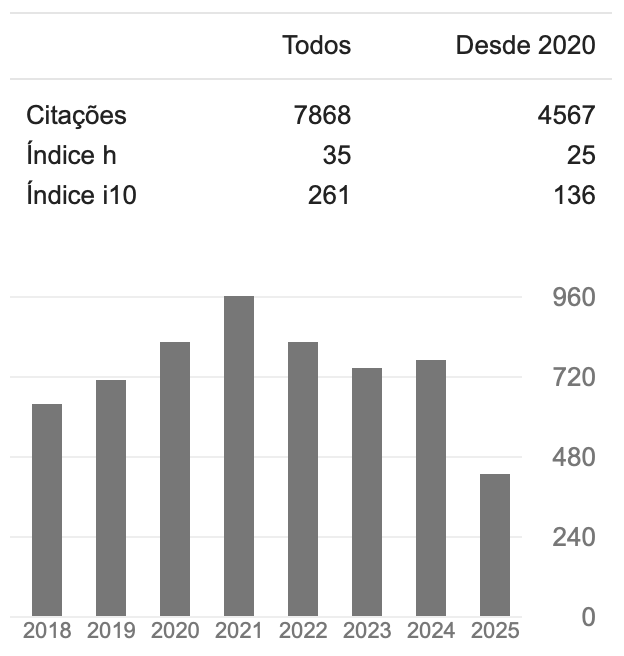Fenótipos digitais para mindfulness e ansiedade encontrados por aplicativo de smartphone
DOI:
https://doi.org/10.17765/2176-9206.2023v16n1.e11196Palavras-chave:
Atenção plena, Aplicativos móveis, Ansiedade, Tempo de reação, TelemedicinaResumo
A pesquisa em telemedicina possibilitou a captação de medidas fisiológicas para encontrar biomarcadores do comportamento humano durante o uso de smartphones chamados fenótipos digitais. A identificação e avaliação desses biomarcadores para diagnóstico da saúde fornece subsídios a uma área afim da telemedicina, a medicina de precisão. Foi desenvolvido um aplicativo para celular chamado Neuropesquisa, que possui recursos voltados a encontrar esses biomarcadores enquanto os usuários preenchem escalas psicológicas para saúde mental. O objetivo foi correlacionar mindfulness, ansiedade e tempo de reação e rastrear possíveis fenótipos digitais dessas pessoas. Realizou-se um estudo observacional, de delineamento correlacional, transversal e remoto com 364 adultos pelo Neuropesquisa. Foram encontradas correlações positivas e significativas entre mindfulness e tempo de reação, e negativas e significativas para ansiedade e tempo de reação. Concluiu-se que Neuropesquisa foi capaz de identificar fenótipos digitais dentre os constructos avaliados, de relevante importância para medicina de precisão e saúde mental.Downloads
Referências
Hjelm NM. Benefits and drawbacks of telemedicine. J Telemed Telecare. 2005;11(2):60-70. doi: https://doi.org/10.1258/1357633053499886
Hollander JE, Carr BG. Virtually Perfect? Telemedicine for Covid-19. N Engl J Med. 2020 Apr 30;382(18):1679-81. doi: https://doi.org/10.1056/NEJMp2003539
Straczkiewicz M, James P, Onnela JP. A systematic review of smartphone-based human activity recognition methods for health research. Npj Digit Med. 2021 Oct 18;4(1):1-15. doi: https://doi.org/10.1038/s41746-021-00514-4
Pastor N, Khalilian E, Caballeria E, Morrison D, Luque US, Matrai S, et al. Remote Monitoring Telemedicine (REMOTE) Platform for Patients With Anxiety Symptoms and Alcohol Use Disorder: Protocol for a Case-Control Study. JMIR Res Protoc. 2020 Jun 24;9(6):e16964. doi: https://doi.org/10.2196/16964
Ball DC, Isaro A, Dogrucu A, Perucic A. Sensing Depression. Worcester: Worcester Polytechnic Institute; 2018. Available from: https://core.ac.uk/download/pdf/212971155.pdf
Zulueta J, Piscitello A, Rasic M, Easter R, Babu P, Langenecker as, et al. Predicting Mood Disturbance Severity with Mobile Phone Keystroke Metadata: A BiAffect Digital Phenotyping Study. J Med Internet Res. 2018 Jul 20;20(7):e9775. doi: https://doi.org/10.2196/jmir.9775
World Health Organization. World mental health report: Transforming mental health for all. [internet]. WHO: Geneva; 2022. Available from: https://www.who.int/publications-detail-redirect/9789240049338
Musse FCC, Castro LS, Mestre TF, Pelloso SM, Poyares D, Musse JLL, et al. Violência mental: ansiedade e depressão durante a pandemia de COVID-19 no Brasil. Saúde e Pesquisa. 2022 Jan 31;15(1):1-17. doi: https://doi.org/10.17765/2176-9206.2022v15n1.e9684
Jacobson NC, Feng B. Digital phenotyping of generalized anxiety disorder: using artificial intelligence to accurately predict symptom severity using wearable sensors in daily life. Transl Psychiatry. 2022 Aug 17;12(1):1-7. doi: https://doi.org/10.1038/s41398-022-02038-1
Grecucci A, Pappaianni E, Siugzdaite R, Theuninck A, Job R. Mindful Emotion Regulation: Exploring the Neurocognitive Mechanisms behind Mindfulness. BioMed Res Int. 2015 Jun 7;2015:e670724. doi: https://doi.org/10.1155/2015/670724
Hoge EA, Bui E, Mete M, Dutton MA, Baker AW, Simon NM. Mindfulness-Based Stress Reduction vs Escitalopram for the Treatment of Adults With Anxiety Disorders: A Randomized Clinical Trial. JAMA Psychiatry. 2023 Jan 1; 80(1):13-21. doi: https://doi.org/10.1001/jamapsychiatry.2022.3679
Duarte DFB, Libório JR, Cavalcante GME, Aquino TL, Bezerra LC, Martin ALAR, et al. The effects of mindfulness-based interventions in COVID-19 times: a systematic review. J Hum Growth Dev. [internet] 2022 Jun 23 [cited 2022 Set 13];32(2):315-26. Available from: https://revistas.marilia.unesp.br/index.php/jhgd/article/view/13313
Jain FA, Okereke O, Gitlin L, Pedrelli P, Onnela JP, Nyer M, et al. Mentalizing imagery therapy to augment skills training for dementia caregivers: Protocol for a randomized, controlled trial of a mobile application and digital phenotyping. Contemp Clin Trials. 2022 May 1;116:106737. doi: https://doi.org/10.1016/j.cct.2022.106737
Onnela JP. Opportunities and challenges in the collection and analysis of digital phenotyping data. Neuropsychopharmacology. 2021 Jan;46(1):45-54. doi: https://doi.org/10.1038/s41386-020-0771-3
Melcher J, Hays R, Torous J. Digital phenotyping for mental health of college students: a clinical review. Evid Based Ment Health. 2020 Nov 1;23(4):161-6. doi: https://doi.org/10.1136/ebmental-2020-300180
Zhang Z, Song Y, Cui L, Liu X, Zhu T. Emotion recognition based on customized smart bracelet with built-in accelerometer. PeerJ. 2016 Jul 26;4:e2258. Doi: https://doi.org/10.7717/peerj.2258
Mayerl J. Response Latency Measurement in Surveys. Detecting Strong Attitudes and Response Effects. [internet] 2013 [cited 2022 Sep 13]. Available from: https://www.ssoar.info/ssoar/handle/document/33766
Serpell BG, Waddington G, McGrath B, Cook CJ. Is There a Link between Stress and Cognition, and Capacity to Execute Motor Skill? Med Sci Sports Exerc. 2020 Nov 1;52(11):2365-72. doi: https://doi.org/10.1249/MSS.0000000000002397
Cardinale EM, Subar AR, Brotman MA, Leibenluft E, Kircanski K, Pine DS. Inhibitory control and emotion dysregulation: A framework for research on anxiety. Dev Psychopathol. 2019 Aug;31(3):859-69. doi: https://doi.org/10.1017/S0954579419000300
Isbel BD, Lagopoulos J, Hermens DF, Summers MJ. Mental training affects electrophysiological markers of attention resource allocation in healthy older adults. Neurosci Lett. 2019 Apr 17;698:186-91. doi: https://doi.org/10.1016/j.neulet.2019.01.029
Figurska M, Stańczyk M, Kulesza K. Humans cannot consciously generate random numbers sequences: Polemic study. Med Hypotheses. 2008;70(1):182-5. doi: https://doi.org/10.1016/j.mehy.2007.06.038
Joppich G, Däuper J, Dengler R, Johannes S, Rodriguez-Fornells A, Münte TF. Brain potentials index executive functions during random number generation. Neurosci Res. 2004 Jun;49(2):157-64. doi: https://doi.org/10.1016/j.neures.2004.02.003
Barros VV, Kozasa EH, Souza ICW, Ronzani TM. Validity evidence of the brazilian version of the five facet mindfulness questionnaire (FFMQ). Psicol Teor Pesquisa. 2014 Sep;30:317-27. doi: https://doi.org/10.1590/S0102-37722014000300009
Vignola RCB, Tucci AM. Adaptation and validation of the depression, anxiety and stress scale (DASS) to Brazilian Portuguese. J Affect Disord. 2014 Feb 1;155:104-9. doi: https://doi.org/10.1016/j.jad.2013.10.031
Gouveia VV, Milfont TL, Fonseca PN, Coelho JAPM. Life Satisfaction in Brazil: Testing the Psychometric Properties of the Satisfaction With Life Scale (SWLS) in Five Brazilian Samples. Soc Indic Res. 2009 Jan 1;90(2):267-77. doi: https://doi.org/10.1007/s11205-008-9257-0
Vasconcellos SJL, Hutz CS. Construção e validação de uma escala de abertura à experiência. Aval Psicológica. [internet] 2008 Aug [citado 2022 set 13];7(2):135-41. Disponível em: http://pepsic.bvsalud.org/scielo.php?script=sci_arttext&pid=S1677-04712008000200004
Brown DB, Bravo AJ, Roos CR, Pearson MR. Five Facets of Mindfulness and Psychological Health: Evaluating a Psychological Model of the Mechanisms of Mindfulness. Mindfulness. 2015 Oct 1;6(5):1021-32. doi: https://doi.org/10.1007/s12671-014-0349-4
Baer RA, Smith GT, Hopkins J, Krietemeyer J, Toney L. Using self-report assessment methods to explore facets of mindfulness. Assessment. 2006 Mar;13(1):27-45. doi: https://doi.org/10.1177/1073191105283504
Fox E. Allocation of visual attention and anxiety. Cogn Emot. 1993 Mar 1;7(2):207-15. doi: https://doi.org/10.1080/02699939308409185
Cash M, Whittingham K. What Facets of Mindfulness Contribute to Psychological Well-being and Depressive, Anxious, and Stress-related Symptomatology? Mindfulness. 2010 Sep 1;1(3):177-82. doi: https://doi.org/10.1007/s12671-010-0023-4
Downloads
Publicado
Como Citar
Edição
Seção
Licença
A submissão de originais para a revista Saúde e Pesquisa implica na transferência da Carta Concessão de Direitos Autorais, pelos autores, dos direitos de publicação digital para a revista após serem informados do aceite de publicação.A Secretaria Editorial irá fornecer da um modelo de Carta de Concessão de Direitos Autorais, indicando o cumprimento integral de princípios éticos e legislação específica. Os direitos autorais dos artigos publicados nesta revista são de direito do autor, com direitos da revista sobre a primeira publicação. Os autores somente poderão utilizar os mesmos resultados em outras publicações, indicando claramente a revista Saúde e Pesquisa como o meio da publicação original. Em virtude de tratar-se de um periódico de acesso aberto, é permitido o uso gratuito dos artigos, principalmente em aplicações educacionais e científicas, desde que citada a fonte. A Saúde e Pesquisa adota a licença Creative Commons Attribution 4.0 International.
A revista se reserva o direito de efetuar, nos originais, alterações de ordem normativa, ortográfica e gramatical, com vistas a manter o padrão culto da língua e a credibilidade do veículo. Respeitará, no entanto, o estilo de escrever dos autores. Alterações, correções ou sugestões de ordem conceitual serão encaminhadas aos autores, quando necessário. Nesses casos, os artigos, depois de adequados, deverão ser submetidos a nova apreciação. As opiniões emitidas pelos autores dos artigos são de sua exclusiva responsabilidade.


















